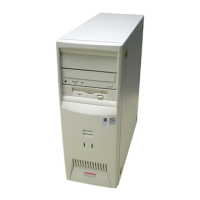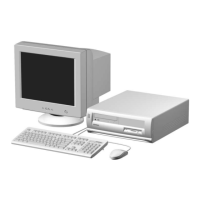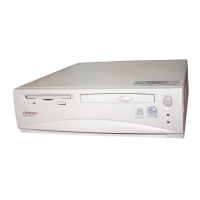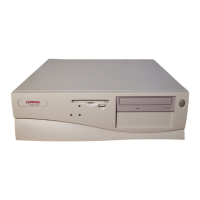Chapter 2 System Overview
Compaq Deskpro EP Series of Personal Computers
First Edition – April 1998
2-8
2.4.1 PROCESSOR
The Intel Celeron and Pentium II processors are backward-compatible with software written for
x86-type and includes the dual-ALU central processing unit (CPU) with branch prediction
support and an integrated L1 cache along with a math coprocessor.
The Intel Celeron processor is a cost-efficient design with the Host bus interface operating at 66
MHz and no L2 cache. This 266-MHz processor is mounted on an open board (with a passive
heat sink) that installs in slot 1and held in place by “goal-post” retainers.
The Intel Pentium II processor includes a 512-KB secondary (L2) cache and is packaged in a
single-edge-connector (SEC) cartridge. The 266-, 300- and 333-MHz processors use a 66-MHz
Host bus interface. The 350- and 400-MHz processors use a 100-MHz Host bus interface. The
SEC cartridge mounts in slot 1 using locking retainers.
Figure 2–7.
Processor Architectural Comparison Diagram
The slot 1 processor mounting system allows for easy replacing and/or upgrading. Refer to
chapter 3 for details concerning exchangeability between processor types in a particular system.
2.4.2 MEMORY
The 66-MHz slot 1 system board includes two 168-pin DIMM sockets allowing expansion up to
256 megabytes. The 100-MHz slot 1 system board provides three 168-pin DIMM sockets
allowing expansion up 384 megabytes. On all models SDRAM modules are recommended and
parity is not used. On 100-MHz slot 1 systems ECC memory is supported.
All models use an easily-upgradeable flash ROM component that contains the BIOS, setup
utility, PCI, and ESCD data.
(Mounted in Slot 1 Connector)
Intel Pentium II Processor
Dual-ALU
CPU w/MMX
Branch
Prediction
Dual Pipeline
Math Coproc.
32-KB
L1 Cache
512-KB
L2
Cache
Intel Celeron Processor
Dual-ALU
CPU w/MMX
Branch
Prediction
Dual Pipeline
Math Coproc.
32-KB
L1 Cache

